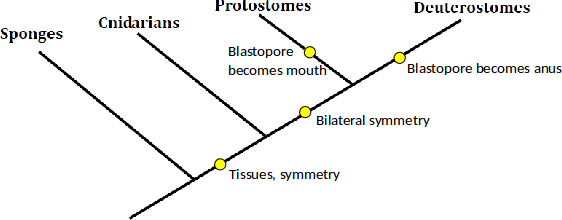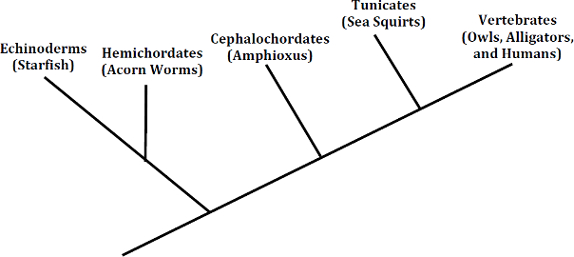Chapter 44 Summary
Core Concepts Summary
44.1 Phylogeny charts the evolutionary relationships among more than a million animal species.
Early biologists grouped animals on the basis of shared features of adult bodies, such as symmetry and type of body cavity. page 946
Embryology provided additional information on animal phylogeny, and, in the age of molecular biology, molecular sequence comparisons have provided still more information. page 948
44.2 The earliest branches of the animal tree include sponges, cnidarians, ctenophores, and placozoans.
Sponges have a simple anatomical organization, feed by drawing water containing dissolved food particles into their interiors, and are widespread in the oceans. page 948
Cnidarians form true tissues, differentiate nerve and musclelike cells, and act as predators by means of specialized cells called nematocysts. page 950
Ctenophores, or comb-
Placozoans have a very simple organization, but genomic data support the hypothesis that they are the sister group to all other eumetazoans. page 953
The evolutionary relationships among sponges, placozoans, and ctenophores remain a subject of research. page 953
44.3 Bilaterians, including protostomes and deuterostomes, have bilateral symmetry and develop from three germ layers.
Protostomes are divided into lophotrochozoans and ecdysozoans. page 956
Lophotrochozoans consist of 17 phyla, including annelid worms and mollusks. page 956
Annelid worms include earthworms and leeches, but most species of annelids live in the oceans. page 956
Mollusks include gastropods (snails, slugs), cephalopods (squid, octopuses), and bivalve mollusks (clams, oysters). page 957
Ecdysozoans include several phyla that molt their cuticle, notably the nematodes and arthropods. page 959
Arthropods can be divided into four main groups—
Deuterostomes include three main phyla—
Well-
Chordates include vertebrates, cephalochordates, and tunicates. page 964
44.4 Most vertebrates have a bony cranium and vertebral column; vertebrates include fish, amphibians, reptiles, birds, and mammals.
The group commonly known as “fish” consists of four distinct groups of aquatic vertebrates: hagfish and lampreys, cartilaginous fish, bony fish, and lobe-
Lungfish are the closest relatives of tetrapods, which include amphibians, lizards, turtles, crocodilians, birds, and mammals. page 969
Amphibians have an aquatic larval form and a terrestrial adult form. page 970
Amniotes, such as lizards, snakes, crocodiles, birds, and mammals, have an amniotic egg, permitting movement into dry, terrestrial habitats. page 970
Mammals are covered with hair and feed their young milk from mammary glands. page 970
44.5 Animals first evolved more than 600 million years ago in the oceans, and by 500 million years ago the major structural and functional body plans of animal phyla were in place.
Ediacaran fossils from 579 million years ago provide evidence of early animals. page 972
The Cambrian explosion was an interval of rapid diversification beginning 541 million years ago, during which time most of the animal body plans we see today first evolved. page 973
Mass extinctions have repeatedly changed the trajectory of animal evolution during the past 500 million years. page 974
Chelicerates and insects were the first animals to colonize the land, sometime after 420 million years ago. page 974
Tetrapods first appear in the fossil record about 360 million years ago. page 975
Mammals originated at least 210 million years ago, but became dominant only after the extinction of the nonavian dinosaurs 65 million years ago. page 975
The fossil record of reef ecosystems reflects a more general pattern of repeated evolutionary innovation and mass extinction. page 975
Self-Assessment
Draw a simplified animal tree of life, indicating the relationships among sponges, cnidarians, protostomes, and deuterostomes.
Self-Assessment 1 Answer

What features distinguish sponges, cnidarians, protostomes, and deuterostomes? Place these features on the phylogeny drawn for Self-
Assessment question 1. Self-Assessment 2 Answer
Deuterosotmes and protostomes are distinguished from each other by features of embryo development. Deuterostomes and protostomes, in turn, are distinguished from cnidarians by bilateral symmetry, triploblastic development, and well-
defined organ systems. Deuterostomes, protostomes, and cnidarians are differentiated from sponges by possessing tissues and body plans with well- defined symmetry. 
Compare and contrast the anatomical organization of sponges and cnidarians. How do these differences shape their functional biology, especially feeding mode?
Self-Assessment 3 Answer
Sponges are made up of three distinct layers: a porous outer layer of interlocking cells, followed by a layer of mesohyl, and finally by an innermost layer composed of (in part) choanocytes. Cnidarians are similarly composed of three different layers: an outer epidermis, a middle mesoglea layer, and an innermost endoderm that lines a distinct gastric cavity. Unlike sponges, cnidarians demonstrate radial symmetry and possess a distinctive mouth into which food is drawn by tentacles. Interestingly, the cnidarian mouth acts as both the entryway for food and exit for waste. Once through the mouth, food enters the gastric cavity and is digested by enzymes. Sponges filter water to feed on bacteria and dissolved organic molecules; cnidarians prey on other animals.
Describe feeding habits that do not require a head.
Self-Assessment 4 Answer
Many feeding methods don’t require a distinct head or mouth, and instead make use of endocytosis. Sponges don’t possess definitive heads, but funnel food-
rich water into a centralized cavity. Cells within this cavity subsequently take up food particles via endocytosis. Placozoans also do not possess heads. To feed, these organisms envelop a food source and release digestive enzymes. Through endocytosis, single placozoan cells will then take up digested material. Filter- feeding also does not require a head, as bivalves, barnacles, and tunicates illustrate. These creatures move water and over surfaces that capture food particles that are moved with mucus toward their digestive systems. Name three features that account at least in part for the success of insects.
Self-Assessment 5 Answer
Insects possess several unique traits, many of which are shared with other arthropods. These include jointed legs and a chitin exoskeleton. Jointed legs have allowed insects to navigate a variety of terrains in diverse environments. Additional characteristics unique to insects include the development of wings and desiccation-
resistant eggs. Collectively, these traits have allowed insects to colonize various terrestrial environments and made them remarkably successful organisms. Desiccation- resistant eggs are important for insects inhabiting and laying eggs in a non- aquatic environment. Wings allow insects to easily move between plants in a habitat and between habitats. Insects that go through metamorphosis have two life cycles specialized for feeding and mating and reproduction. Draw a phylogeny of deuterostomes, indicating the most likely relationships among chordates, hemichordates, and echinoderms, with common examples of each group.
Self-Assessment 6 Answer

List features common to bony fish, amphibians, amniotes, and mammals.
Self-Assessment 7 Answer
All of these organisms have a jointed and mineralized skeleton, a cranium-
encased brain, and a vertebral column. Animals classified as amniotes, amphibians, and mammals demonstrate additional characteristics unique to the phyla. For example, amniotes— much like insects— are characterized by desiccation- resistant eggs. Mammals are classified by the appearance of mammary glands and hair, whereas amphibians demonstrate a gill- based larval stage and lung- focused adult stage. Describe the evolutionary significance of the Cambrian explosion.
Self-Assessment 8 Answer
The Cambrian Explosion holds great evolutionary significance, as it brought with it the development of a diverse array of novel animal body plans (e.g., the combination of new characters in a single animal) reminiscent of those seen in modern-
day organisms. In earlier Ediacaran fossils, such familiar characteristics are not observed.